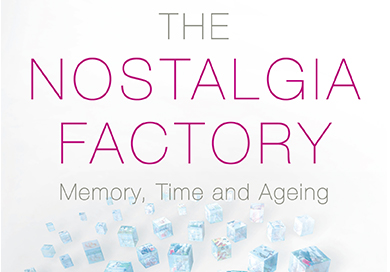For the Agony and Ecstasy of Remembrance
Life can only be understood backwards; but it must be lived forwards. – Søren Kierkegaard
We constantly seek to delay the inconveniences of mortality for as long as humanly possible, as can be seen in the launch of Google’s startup Calico as well as the deluge of anti-aging products and homeopathic supplements on the market. We want not only our bodies to feel younger but our minds as well. An equally strong collective obsession is our striving to preserve our mind from memory-draining illnesses such as Alzheimer’s through ginkgo biloba and fish oil as well as mind games and crossword puzzles. We want to record our present selves through photos and social me and the theme of memory is an ever popular theme in famous works of literature: Marcel Proust’s unforgettable À la recherché du temps perdu ; Jorge Luis Borges’s short story “Funes el memorioso” ; Vladimir Nabokov’s memoir Speak, Memory; and Ian McEwan’s novel Atonement. Thanks to the advances of technology, we don’t have to resign ourselves to becoming deaf or blind. Similarly, we want don’t want to resign ourselves to the eventual atrophy of our minds.
 The Nostalgia Factory: Memory, Time and Ageing by Douwe Draaisma allows readers of all ages and backgrounds to learn more about how the mind works emotionally and physically in response to the passing of time. Translated into English by Liz Waters, this book debunks many myths that we have collectively propagated over time. Memory is not a video camera continually recording the time and date along with the picture and sound. It can be altered, manipulated, distorted by filters such as external influence, an emotional state, or your retrospective mental state. Nor is memory a muscle that can be trained; rather it is one’s mastery of memory strategies that allows one to memorize astonishing amounts of information. No single study has demonstrated that we use only 10% of our brains. Many elderly people are convinced that if you were asked to memorize a lot of things as a child, then you will have a well-trained memory. Not true.
The Nostalgia Factory: Memory, Time and Ageing by Douwe Draaisma allows readers of all ages and backgrounds to learn more about how the mind works emotionally and physically in response to the passing of time. Translated into English by Liz Waters, this book debunks many myths that we have collectively propagated over time. Memory is not a video camera continually recording the time and date along with the picture and sound. It can be altered, manipulated, distorted by filters such as external influence, an emotional state, or your retrospective mental state. Nor is memory a muscle that can be trained; rather it is one’s mastery of memory strategies that allows one to memorize astonishing amounts of information. No single study has demonstrated that we use only 10% of our brains. Many elderly people are convinced that if you were asked to memorize a lot of things as a child, then you will have a well-trained memory. Not true.
But there are certain aspects of our mind that feel incontrovertible because we all experience them. The feeling of having a memory or recollection at the tip of one’s tongue is universal and many joke that the inability to remember is a frustrating indicator of growing old. Though you can’t recall the information you are looking for, it does not necessarily mean that you have forgotten it. The memory may be hidden and may re-emerge later. The “feeling of knowing” or “Oh, yes knowledge” is not synonymous with never having learned that information. The Nostalgia Factory enlightens the reader with how certain aspects of memory-loss are natural among the entire senior-citizen population while other aspects reveal the onset of dementia.
Draaisma also embarks on the mysterious subject of nostalgia. We always associate reminiscence and nostalgia with elderly people, who seem to wax poetic about the “good old days” and talk ceaselessly about their youth. At times it can be painful to watch as we see the minds of our dementia-stricken friends or relatives decline: though they get lost in remembering a conversation from 80 years ago, they can’t recall what they ate for lunch mere hours before. We struggle to define at what age we become “old,” but it is hard to deny that humans actually spend more time being “old” than being “young.” As a consequence, we spend more time dwelling on our past, our younger days, than we do about our future that is winding down.
And this long-term dwelling on our past is inextricably connected to the feeling of nostalgia. The original meaning of nostalgia related to a pining for home; nostos meaning “return home” and algo meaning “pain.” Draaisma discusses the intense feelings of nostalgia that accompanied Dutch emigrants as they struggle to acclimate themselves to their new country, be it in North America, South Africa, or Australasia, shortly after World War II. Nostalgia hit everyone at different times. Some people battled with nostalgia-induced depression from the start, while others felt the pangs of nostalgia decades later. Young emigrants dream about their childhood, old immigrants about the early years of their new life.
But emigrants and old people are not the only ones prone to nostalgia. Perhaps you just graduated college and returning to your childhood room–be it frozen in time since your departure or completely changed because you’ve moved out– leaves you yearning for how things were. Or maybe you live in a city and witnessing the gentrification of a former slum provokes mixed feelings within you.
In 1846 the French doctor Louis Alexandre Hippolyte Leroy-Dupré predicted that nostalgia would soon cease to exist. ‘Cerebral nostalgia becomes rare each day thanks to rapid communications which modern industry is beginning to establish among people who will soon be nothing more than one big family.’ But it’s not necessarily the distance that determines whether or not one falls victim to nostalgia. Even with transatlantic flights, Skype, Facebook, and WhatsApp, the power of memory and the bittersweet taste of nostalgia are more potent than ever. Where you have moved across the country or across the hall, our journey through time makes us emigrants of our own past, and we must manage the unpredictable ebb and flow of memories with its requisite side effect of nostalgia as a means to provide comfort more than pain.
In The Nostalgia Factory, Draaisma interviews renowned researcher Oliver Sacks about an article he wrote on memory in light of his sixtieth birthday. You can read the article via the New York Review of Books here.


























